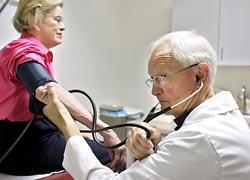Originally published June 26, 2005 at 12:00 AM | Page modified March 16, 2010 at 4:53 PM
The hidden big business behind your doctor's diagnosis
The hidden big business behind your doctor's diagnosis: What can go wrong when the drug industry influences what constitutes disease, who has it, and how it should be treated.
Seattle Times staff reporters
HARLEY SOLTES / THE SEATTLE TIMES
Dr. Robert Saunders checks the blood pressure of Seattle City Councilwoman Jean Godden, who had a close call with a hypertension drug. Saunders expresses concern about company-backed research behind some medicines. "I think the days of getting unbiased information are gone," he says.
You walk into your doctor's office for a physical exam and step on the scale. Last year, the doctor said you were overweight. Now he says you are obese — at the same weight.
A nurse takes your blood pressure. You have hypertension — with the same previously healthy reading you've had for years.
The doctor scans your wrist bone. You have a condition called "osteopenia" — with the same bone density that was fine last time you were measured.
You mention you are not enjoying sex as much as you used to. Diagnosis: a new kind of sexual dysfunction.
You leave the office with a head full of worry and a fistful of new prescriptions, joining more than 40 percent of Americans who take one or more prescribed drugs daily in the effort to stave off more serious trouble.
You are suddenly sick, simply because the definitions of disease have changed. And behind those changes, a Seattle Times examination has found, are the companies that make all those newly prescribed pills.
The Times found that:
• Pharmaceutical firms have commandeered the process by which diseases are defined. Many decision makers at the World Health Organization, the U.S. National Institutes of Health and some of America's most prestigious medical societies take money from the drug companies and then promote the industry's agenda.
• Some diseases have been radically redefined without a strong basis in medical evidence.
• The drug industry has bolstered its position by marketing directly to the health-conscious consumer, leading younger and healthier people to consider themselves at risk and to start taking medications.
Every time the boundary of a disease is expanded — the hypertension threshold is lowered by 10 blood-pressure points, the guideline for obesity is lowered by 5 pounds — the market for drugs expands by millions of consumers and billions of dollars.
The result? Skyrocketing sales of prescription drugs. Soaring health-care costs. Escalating patient anxiety. Worst of all, millions of people taking drugs that may carry a greater risk than the underlying condition. The treatment, in fact, may make them sick or even kill them.
Dartmouth Medical School researchers estimate that during the 1990s, tens of millions more Americans were classified as having hypertension, high cholesterol, diabetes or obesity simply because the definitions of those diseases were changed.
Today, three of every four Americans technically have at least one of those diseases. But millions of them are not truly sick and may never be, even without medication. The Dartmouth researchers said it was unknown whether those people would benefit from early detection and treatment, while it is "an open question" whether branding them diseased and feeding them drugs may be causing significant physical or psychological harm.
The medical profession's term for these people is "the worried well." They are otherwise healthy people who have risk factors, such as high blood pressure or high cholesterol, but may never suffer a heart attack or stroke.
Dr. Alfred Berg, chairman of family medicine at the University of Washington and a past chairman of a federal task force that fights drug-industry influence on disease and treatment guidelines, said the best advice for many people at risk of so-called "lifestyle diseases" is to simply change their lifestyles.
"Diet and exercise and righteous living — but nobody wants to hear that," Berg said.
Instead, he says, a "commercial prevention" industry has emerged, focused on selling drugs to people who don't really need them but who can pay for them.
"We have a system that nobody but Big Pharma is happy with," says Dr. John Kitzhaber of The Foundation for Medical Excellence in Portland, who was Oregon's governor from 1995 to 2003.
But the drug companies can't do it alone. They need, and receive, support from much of the world's medical establishment.
Treatment guidelines established by international and national health organizations instruct physicians on diagnosis and treatment of disease and are meant to be scientifically pristine. But many of those groups lack any process for preventing or disclosing conflicts of interest.
The Times found that for a broad spectrum of diseases, the experts writing the treatment guidelines had drug-company ties ranging from research contracts to consultancies to stock ownership.
Berg's group, the U.S. Preventive Services Task Force, flatly prohibits any conflicts of interest, either in money or previous research. As a result, it is consistently more conservative in its recommendations than other medical guideline-writing groups and pushes fewer drugs.
Dr. H. Gilbert Welch, a Dartmouth medical professor and editor of Effective Clinical Practice, a journal of the American College of Physicians, agrees that his profession shares the blame for what he sees as an overdose of preventive medicine.
The problem begins, he said, with the expanding definitions of disease.
"You can't tell me that three-quarters of my population is sick before I start," he said. "That just doesn't pass the laugh test.
"Our business is in a hard place right now," Welch said. "A lot of docs know it's not right."
Duff Wilson reported and co-wrote this story while working for The Seattle Times. He now reports for The New York Times. Send comments to suddenlysick@seattletimes.com or call Susan Kelleher: 206-464-2508.
Entertainment | Top Video | World | Offbeat Video | Sci-Tech
general classifieds
Garage & estate salesFurniture & home furnishings
Electronics
just listed
More listings
POST A FREE LISTING



